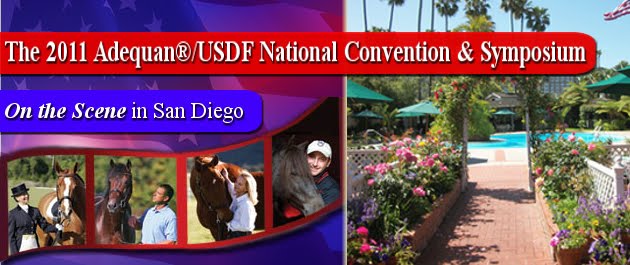I had hoped that my flight home would be equipped with WiFi, so that I could upload this blog post while airborne; and laptop power ports, so that I could start going through the thousands of images USDF photographer Bruce Lawrie and I took at this weekend’s Adequan/USDF National Symposium. Alas, neither option was available, so I’m composing this post on battery power and will upload it as soon as I get home. The photos will have to wait until tomorrow.
In a word, the symposium was spectacular. USDF pulled out all the stops to ensure a memorable event, and symposium organizer Kathie Robertson did a masterful job of wrangling the 29 (!) demonstration horses, their entourages, and the riders.
“The American program” was the theme, and the fact that a symposium could be thus titled is in itself quite a statement. For decades there has been no American dressage program at all, really, save for drop-in visits by foreign coaches. The USDF has tried to facilitate the development of horses and riders through its Junior/Young Rider program and others, and the US Equestrian Federation started its Young Horse program about a decade ago; but there was no system for the discovery and nurturing of promising human and equine dressage talent.
That has all changed. Within the past few years, the USEF has hired a national dressage youth coach (Jeremy Steinberg), a developing coach (Debbie McDonald), and a technical advisor/high-performance coach (Anne Gribbons) to work alongside young-horse coach Scott Hassler. They travel around the country giving clinics and playing talent scout. A gifted young horse, for example, might begin under Scott’s program, later move on to Debbie’s realm, and (ideally) finally ascend the ranks to work with Anne in making the transition to representing the United States in international competition.
The 2011 USDF symposium brought the coaching quartet together for the first time. Together and separately, they worked with horses and riders who fall under their various domains. Beginning with a junior rider working on her seat in a lunge lesson and concluding with Grand Prix test tweaks with 2012 Olympic hopefuls Adrienne Lyle and Wizard, the event was a live demonstration of the new American dressage pipeline in action.
From Correctness, Competitiveness
Although the four coaches hail from different backgrounds, there was a remarkable similarity to their training approaches. For each coach, with each horse and rider, the work is all about correct—truly correct—basics. The horse must learn to respond properly to the forward driving aids and, through tactful riding, to accept a correct and consistent connection to the bit. The gymnastic development of the dressage horse, and particularly of a supple and swinging back, is an incremental process that cannot be rushed or forced. Riders must develop their own fitness and suppleness with as much dedication as they do their horses’. There is no point in working on higher-level movements during a training session until the basics have been established. (Gribbons had Lyle ride a tense Wizard through an extended series of Gribbons’ so-called Prozac exercise—ten-meter half-circle “teardrops” in opposite directions—until the big gelding got sufficiently bored that he relaxed in mind and body.)
The other area of similarity was the coaches’ insistence on attention to detail. “Have a purpose in your riding,” Hassler said. No meandering on the buckle during walk breaks: Horses must continue to stretch and march, even on a long rein. No corners ridden without taking full advantage of the time to prepare the horse for what comes next. Most important, no tolerance for failure to respond promptly to a leg aid. If the horse doesn’t react to a leg aid, he’s behind the leg; it’s that simple. And a horse that is behind the leg cannot be connected, engaged, or properly influenced. Fixing inattentiveness to the driving aids requires hawklike attention to every step of every ride, from the moment you get on to the moment you dismount. Most riders don’t do it. The few who do—well, those are probably the ones at or near the top.
As Gribbons pointed out, her job as the elite coach is to use her FEI 5* judge’s eye to help riders prepare for competition. And riding a test, she emphasized, is different from riding for schooling purposes. This does not mean, however, that the two are mutually exclusive.
“Without correct training,” Gribbons said, “there can be no success in competition.”



























